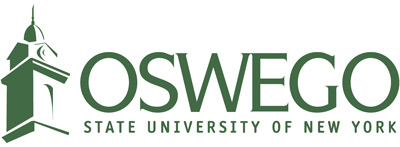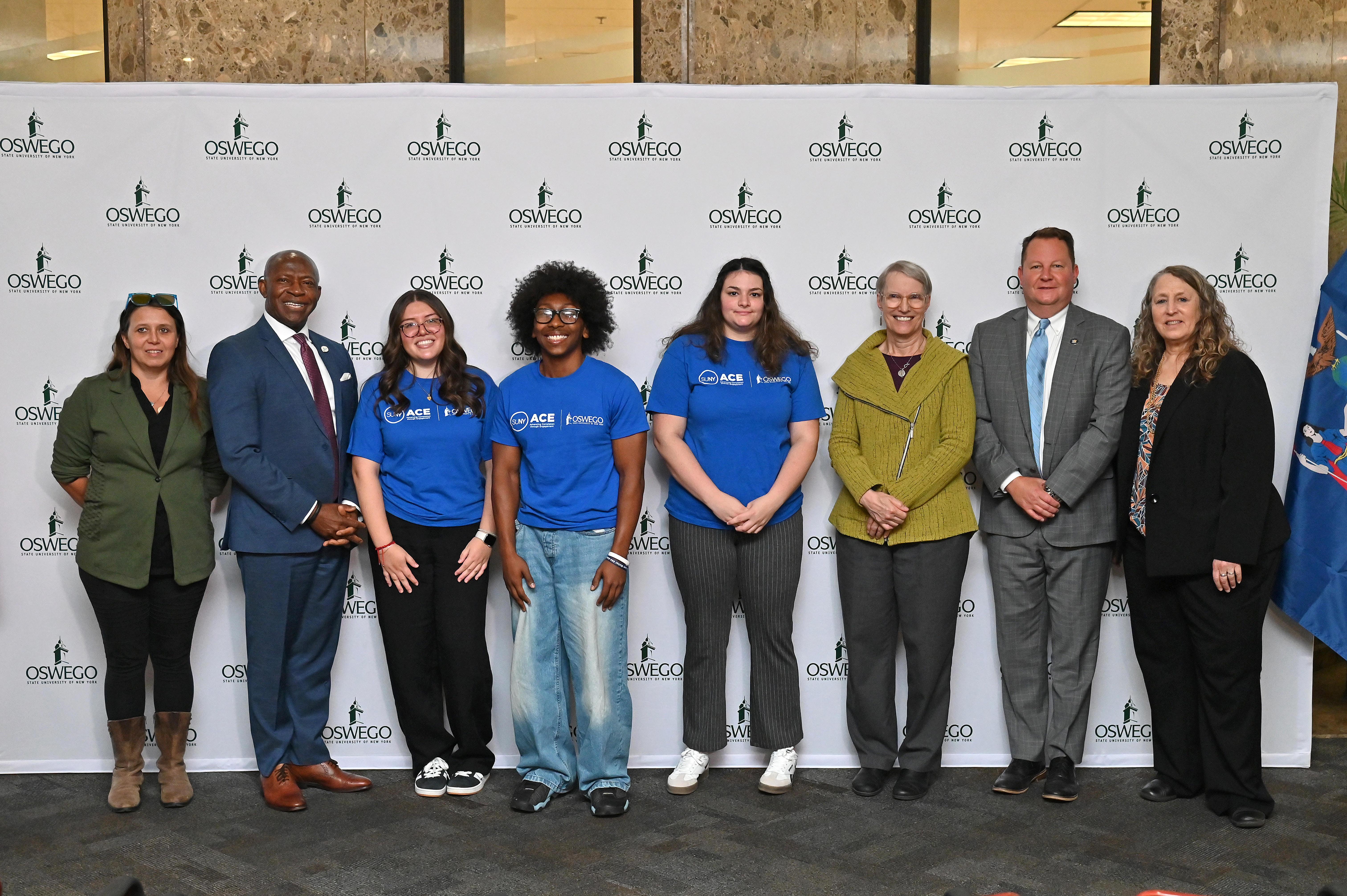SUNY Oswego students, administrators, supporters and elected officials recently gathered at its Syracuse Campus to celebrate the success of SUNY's Advancing Completion through Engagement (ACE) program, where Oswego has the largest cohort with 409 students. Shown from left are Tina Zagyva, representing Assemblymember Pamela Hunter and a SUNY Oswego graduate; SUNY Oswego President Peter O. Nwosu; ACE students Rachael Rose, Jovani Robledo and Liza Crouse; State Senators Rachel May and Chris Ryan; and Senior Vice Chancellor for Student Success Donna Linderman, who led the creation of the ACE program.
With 409 participants, SUNY Oswego has the largest participation in SUNY's Advancing Completion through Engagement (ACE) program, supporting student success and retention. The university and partners recently marked the occasion by sharing student stories and the insights of officials at an event at SUNY Oswego's Syracuse Campus on Oct. 2.
ACE provides both financial resources and wraparound support to remove barriers to full-time study, help students gain and maintain academic momentum, and foster a connected community among students, all in service of increasing timely degree completion.
“The strength of ACE lies in its holistic approach,” SUNY Oswego President Peter O. Nwosu said. “It provides students with the financial support they need to cover essentials such as textbooks, groceries and transportation — the everyday costs that often become barriers to staying in school. It also offers comprehensive academic support, from tutoring and personalized advising to career counseling, ensuring that students have the guidance and resources to succeed in the classroom and beyond.”
Just as important, President Nwuso said, the ACE program “fosters a true sense of community by surrounding students with mentors, peers and a support network that helps them stay on track and move confidently toward graduation.”
After one year, the program is showing success, he noted.
"While the overall retention rate for the program is 76.6 percent, it is more dramatic when you compare ACE students with non-ACE students from similar backgrounds –– first-gen, Pell-eligible or from underrepresented backgrounds," President Nwosu said. "In fact, 84 percent of our ACE students from these high-risk populations returned for their second year, compared to just 69 percent of similar students not enrolled in ACE. That gap demonstrates the power of ACE to change trajectories and open doors that might otherwise remain closed to them."
Attendees also had the opportunity to hear Oswego students Liza Crouse, Jovani Robledo and Rachael Rose; Senior Vice Chancellor for Student Success Donna Linderman, who led the creation of the ACE program; and State Senators Chris Ryan and Rachel May, among others.
Connections and support
“One thing that has been really meaningful is connecting with other students in the ACE program, especially since many of us are first-generation students,” said Crouse, a childhood education major. "Being a first-generation student is something I take a lot of pride in, but it also comes with challenges, like not always knowing what to expect or who to turn to. Having a community of people who understand that experience has made me feel supported and less alone.”
“ACE helped me in many ways. They supported me with funding,” said Robleno, a marketing major. “They helped me connect with resources on campus that I would not have found on my own. I love the school. … I’ve made a ton of new friends. I love everybody there. … It’s giving me the supportive community I need to succeed. And I truly feel grateful to be a part of it.”
“Overall, ACE has helped me turn confusion into confidence. It has given me the support system I was missing and the encouragement to keep pushing forward, not only for myself but for my family as well,” said Rose, a major in adolescence education and Spanish. “I’ve also been able to connect with other students in the program, many of whom share similar experiences. Having that community to lean on has reminded me that I’m not alone in this journey.”
“What makes today especially exciting for me is to be here at Oswego, the largest ACE program in the system,” Linderman said, noting that more than 7,000 students are in ACE and ASAP (Advancing Success in Associate Pathways, for community colleges) programs, with 25 of the 34 campuses having waitlists.
“Students who participate in ASAP and ACE attempt and earn more credits, they’re retained at higher rates and they graduate on time,” Linderman said. “This is a sure bet, and it really is an investment that is very wise as we think about the trajectories of our students and the needs of the state of New York.”
In the 2025-26 State Budget, Governor Kathy Hochul and state leaders allocated $12 million for SUNY to expand this initiative, helping SUNY Oswego to support more students as they pursue a degree to help them unleash their full potential. The significant investment by Governor Hochul and state leaders will help grow ASAP|ACE enrollment statewide, on track to enroll 10,000 students for fall 2026.
“SUNY is committed to the success of every student, and our expansion of the proven ASAP and ACE programs across our system ensures our students are on track to complete their degree on time and pursue their aspirations,” Chancellor John B. King Jr. said of the program. “I applaud Governor Hochul and state leaders for their continued support of SUNY, and I thank the SUNY Oswego administration, faculty and staff for their unwavering commitment to student success.”
For more information on ACE at SUNY Oswego, visit ww1.oswego.edu/advisement/ace.




